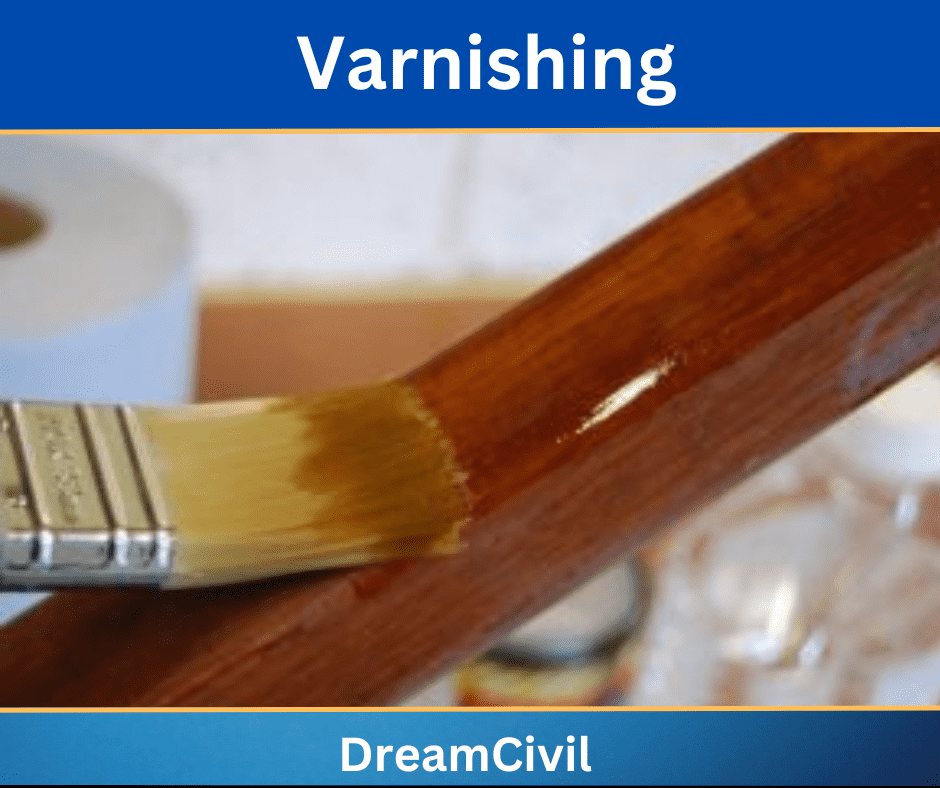Table of Contents
Varnish may be defined as a mixed solution of resins or resinous substances (such as common resin, amber, copal, shellac, etc.) in alcohol, turpentine, or oil.
Varnishing is utilized on wood surfaces with the following products:
(i) To intensify or brighten the appearance of natural grains
(ii) To render brilliance to the painted surface.
(iii) To protect the painted surface from atmospheric action.
(iv) To protect unpainted wooden surfaces of doors, windows, floors, roof trusses, etc. from atmospheric action.

1. Characteristics of a Good Varnish
A good varnish should possess the following characteristics
1. It should dry quickly.
2. The protective film obtained on drying should be hard, tough, durable, and resistant to wear.
3. The finished surface should be uniform in nature and pleasing in appearance.
4. It should exhibit a glossy surface.
5. It should not shrink or show cracks on drying.
6. It should have sufficient elasticity.
7. The color of the varnish must not remove with time.
2. Ingredients of Varnish
Varnish has the following essential ingredients :
(i) Resins or resinous substances.
(ii) Solvents
(iii) Driers.
1. Resins or resinous substances
The quality of varnish pivots largely on the type of resin utilized. There are various types of resins in utilizing copal, lac or shellac, resin, amber, mastic, gum dammer, etc. Copal is a hard and lustrous resin collected from the ground where pine trees existed in past. Resin is collected from pine trees.
Lac or shellac is collected by the exudation of some insects which grow on some type of tree in India. Raw copal, an inferior type, is obtained from standing pine trees.
Type of resin
Amber, copal Lac or shellac Mastic, gum dammer, rosin Raw copal, and other cheap varieties of resin.
2. Solvents
There are various types of solvents are found, but each is utilized only in conjunction with some specific resin.
Type of solvent
1. Boiled linseed oil
2. Methylated spirit of wine
3. Turpentine
4. Wood Naphtha
| Read Also: All About Paint |
3. Driers
Driers accelerate the process of drying a varnish. Common driers used in are litharge, white copper, and lead acetate.
Type of varnishes Varnishes may be divided into the following four categories, depending upon the type of solvent used
1. Oil varnishes.
2. Spirit varnishes.
3. Turpentine varnishes.
4. Water varnishes.
1. Oil varnishes
These varnishes use linseed oil as a solvent in which hard resins such as amber and copal are dissolved by heating. These varnishes dry slowly but form hard and durable surfaces. Sometimes, a small quantity of turpentine is added to make the varnish more workable. Oil varnishes are recommended for all external woodwork, and for joinery and fittings.
2. Spirit varnishes or lacquers
These varnishes are a methylated spirit of wine as a solvent in which soft resins ch such as lac or shellac are dissolved. They dry quickly but are not durable. French polish is a variety of this type of varnish. It is commonly used on furniture.
3. Turpentine varnishes
These varnishes use turpentine as a solvent in which soft resins such as gum dammer, mastic, and rosin are dissolved: The varnish dries quickly but is not so durable. These are cheaper than oil varnishes.
4. Water varnishes
These varnishes are formed by dissolving shellac in hot water, using enough quantity of either ammonia, borax, potash, or soda. Water varnishes are used for varnishing wallpapers, maps, pictures, book jackets, etc.
3. Process of Varnishing
Application of varnish on woodwork is carried out in the following steps :
1. Preparation of the surface
The wood surface is made smooth by thoroughly rubbing it by means of sandpaper or pumice stone.
2. Knotting
The process of knotting is carried out exactly in the same way as adopted for painting woodwork.
3. Stopping
Stopping is done by means of hot weak glue size so that pores on the surface are filled up. Alternately, boiled linseed oil can be applied in two coats. The dry surface should then be rubbed down with sandpaper.
4. Coat of varnish
On the cleaned surface, two or more coats of varnish are applied. The next coat is applied only when the previous coat has dried up thoroughly.
4. Use of Varnish
The uses of varnish are as follows:
a. It provides protective coatings for wooden surfaces, paintings, and various decorative objects.
b. It is used in dentistry, motor winding, oil painting, etc.
c. It protects the painting from dirt and dust
| Read Also: Emulsion Paint |
5. Advantages of Varnishing
The advantages of varnishing are as follows:
a. It provides a natural look to the products.
b. It protects from chemical agencies.
c. Increase the durability of the paint.
d. Makes product durable in which it is applied.
e. More molecular stability.
f. A higher concentration of resin.
g. It provides a thicker finish.
h. Simple application.
i. Enabled at one degree of brightness (glossy).
j. Bright finishing.
6. Disadvantages of Varnishing
The disadvantages of Varnish are as follows:
1. It is costly.
2. It’s not robust so it shouldn’t be flood-resistant.
3. More resistant than urethane varnish.
4. Clear and bad scent.
5. Turns yellow in time.
6. Dry painfully.
7. Needs to wear a mask, otherwise affects the respiratory system.
8. Masks the grain of the trees.
3. References1. Content Filter & Authenticity Checking Team, Dream Civil International (Our team checks every content & detail to maintain quality.) |
Read Also: How To Calibrate The Paint Thickness Gauge

